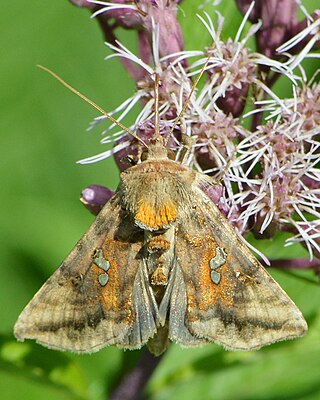
The bimaculated lark breeds in warm temperate countries eastwards from Turkey into Central Asia. It is the eastern counterpart of its relative, the calandra lark.
Tridecane or n-tridecane is an alkane with the chemical formula CH3(CH2)11CH3. Tridecane is a combustible colourless liquid. In industry, they have no specific value aside from being components of various fuels and solvents. In the research laboratory, tridecane is also used as a distillation chaser.

Elaphe bimaculata, the twin-spotted ratsnake or Chinese leopard snake, is a small ratsnake (60–80 cm) found in China. It occurs as both blotched and striped phase, with the blotched type being the more common or "typical" phase. Some specimens even exhibit a pattern of half blotched, half striped where the anterior half is usually blotched and the posterior half striped. They are found in many habitats ranging from the edge of forest to cultivated areas and seem to like cooler temperatures and higher humidity. This secretive snake prefers smaller food items such as young to half grown mice. E. bimaculata has been known to breed at different times of the year, usually with 3-10 eggs being laid in late spring; eggs require 35–48 days of incubation. A period of 2–3 months hibernation is typical. Females are known to grow larger and heavier than males.

Lomographa bimaculata, the white-pinion spotted, is a species of geometer moth. It belongs to the large geometer moth subfamily Ennominae, and therein to the tribe Baptini. It is – under its junior synonym – the type species of its genus Lomographa. It is also the type species of Bapta, a junior objective synonym of Lomographa and the namesake of the Baptini. The species was first described by Johan Christian Fabricius ion 1775.

Autographa bimaculata, the two-spotted looper moth, twin gold spot or double-spotted spangle, is a moth of the family Noctuidae. The species was first described by James Francis Stephens in 1830. It is found in North America from Newfoundland west, just short of the coast of British Columbia, north to the Northwest Territories and south to New Mexico in the west and Pennsylvania and Long Island in the east.

Opharus bimaculata is a moth of the family Erebidae. It was described by Hermann Dewitz in 1877. It is found in Puerto Rico, Guatemala, Costa Rica, Honduras, Venezuela and Brazil.
Ischnolea flavinota is a species of beetle in the family Cerambycidae. It was described by Galileo and Martins in 1993. It is known from Brazil and Paraguay.
Ischnolea inexpectata is a species of beetle in the family Cerambycidae. It was described by Galileo and Martins in 1993. It is known from Brazil.
Ischnolea oculata is a species of beetle in the family Cerambycidae. It was described by Galileo and Martins in 1993. It is known from Brazil.
Ischnolea singularis is a species of beetle in the family Cerambycidae. It was described by Galileo and Martins in 1993. It is known from Brazil.
Ischnolea piim is a species of beetle in the family Cerambycidae. It was described by Galileo and Martins in 1996. It is known from Brazil.
Ischnolea peruana is a species of beetle in the family Cerambycidae. It was described by Breuning in 1943. It is known from Peru.
Ischnolea spinipennis is a species of beetle in the family Cerambycidae. It was described by Breuning in 1943. It is known from Brazil.
Ischnolea indistincta is a species of beetle in the family Cerambycidae. It was described by Breuning in 1942. It is known from Brazil.
Ischnolea longeantennata is a species of beetle in the family Cerambycidae. It was described by Breuning in 1942. It is known from Brazil.
Ischnolea strandi is a species of beetle in the family Cerambycidae. It was described by Breuning in 1942. It is known from Brazil.
Ischnolea crinita is a species of beetle in the family Cerambycidae. It was described by Thomson in 1860. It is known from Brazil and Ecuador.

Epitheca bimaculata, the Eurasian baskettail or two-spotted dragonfly, is a species of dragonfly. It was described by Toussaint de Charpentier in 1825 and initially placed in the genus Libellula. It is the type species of the genus Epitheca.

Diplecogaster bimaculata, the two-spotted clingfish, is a species of fish in the family Gobiesocidae found in Black Sea, Mediterranean Sea and Atlantic Ocean where it is found on rocks and among seagrass or shell beds.

Anthophora bimaculata is a species of bee.







